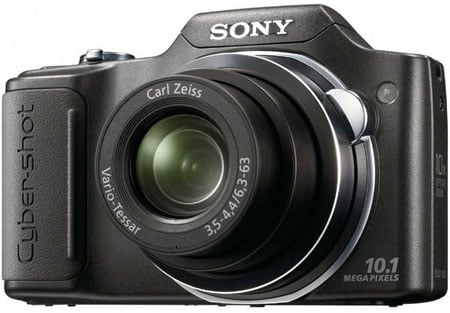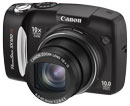Sony Cyber-shot DSC-H20
-
-
Written by Gordon Laing
Sony Cyber-shot DSC-H20 verdict
The Sony Cyber-shot DSC-H20 is a 10 Megapixel budget super-zoom camera with a 10x stabilised zoom and a 3in LCD panel. It provides full manual exposure control as well as a choice of automatic modes, scene recognition and a range of scene presets. It also provides an Easy mode for point-and-shoot picture taking, making it an attractive option for photographers of all abilities.
The Cyber-shot DSC-H20 doubles up as a capable camcorder with 720p HD video recording at two quality settings as well as VGA recording, and you can use the 10x optical zoom while filming.
The Cyber-shot H20 produces superb quality images with excellent detail that will stand up to viewing and printing at the maximum size their resolution allows – about A3. But while image quality is great at lower ISO settings, at 400 ISO and above noise becomes a real issue.
The Cyber-shot DSC-H20 is an excellent all-round performer with a long zoom for the money, but it isn’t the ideal camera for every situation. While it’s 380mm (equivalent) maximum zoom will get you in close to to the action, at the other end of the range its wide-angle coverage is quite limited. Indeed the Cyber-shot DSC-H20’s 38mm wide angle setting will make life difficult when photographing large groups, cramped interiors or at times when you literally can’t stand back any further. And while it’s great to have manual exposure controls, the two-aperture settings are fairly limiting in what’s possible.
 |
Compared to Canon PowerShot SX120 IS
The Canon PowerShot SX120 IS is the biggest rival for the H20. Both cameras share the same resolution, the same screen size and essentially the same zoom range. Both models also have optical image stabilisation and an integral flash. The Cyber-shot is smaller and lighter than the PowerShot, but lacks an integral lens cover.
While both cameras suffer from limited wide angle performance (the Cyber-shot is marginally worse than the PowerShot SX120 in this respect with a 38mm equivalent maximum wide angle) the Cyber-shot slightly outreaches the Canon with a maximum zoom of 380mm equivalent. That said, there’s not much between their ranges when compared side-by-side, so we wouldn’t make a decision based on this alone.
The Cyber-shot comfortably outscores the PowerShot on video performance though, boasting a 720p HD movie mode and a zoom you can use while filming. In our tests the Cyber-shot H20 also produced better quality images that the PowerShot at low sensitivities, with better fine image detail, but performed less well when it came to shooting in low light at High ISO settings.
In terms of shooting modes and exposure control the PowerShot has the edge, with Aperture and Shutter Priority modes, along with manual focusing. We also found its manual controls easier to use and it provides more control over exposure with a range of aperture settings by comparison with the Cyber-shot’s two.
Other differences between the cameras include power supply (AA vs proprietary Li-ion), media type (SD vs memory Stick DUO) and connector type (USB vs proprietary connector) on the Canon and Sony respectively, but these are fairly minor issues. Where it counts, the Sony Cyber-shot DSC-H20 has more to offer – it’s lighter and more compact than the SX120 IS, boasts HD movies with optical zooming and better quality images at low sensitivities. Having said that, if manual control of exposure and focus is important to you, the SX120 IS has more to offer in this respect. See our Canon PowerShot SX120 IS review for more details.
Compared to Canon PowerShot SX200 IS
Canon’s PowerShot SX200 IS costs up to 50% more than the H20, but is a smaller alternative for anyone looking for a super-zoom camera. Most obviously the SX200 IS is more compact, and better-able to squeeze into a pocket, albeit with slightly less to grip onto as a consequence.
The zoom range is 12x to the H20’s 10x, and importantly starts at a much wider equivalent of 28mm, and ending only slightly shorter at 336mm. It also has two extra Megapixels in its favour.
The 3in / 230k screen is the same size and resolution, and both models also share full manual control over exposures. The SX200 IS does however have one more ace-card up its sleeve in the form of an HDMI port for making HD slideshows on a compatible HDTV; annoyingly though you still can’t optically zoom while filming – a key advantage of the Sony.
But with a wider zoom, two extra Megapixels, and an HDMI port in a more pocketable form factor, the PowerShot SX200 IS certainly gives you a lot of extra features for its slightly higher price tag. If you can stretch beyond the price of the H20, it’s certainly worth considering, but also check out the Panasonic below. See our Canon powerShot SX200 IS review for more details.
Compared to Panasonic Lumix DMC-TZ7 / ZS3
Panasonic’s Lumix DMC-TZ7 / ZS3 also costs up to 50% more than the H20, but like the SX200 IS above, you get quite a bit more for your money. Again, most obviously the Panasonic is more compact, and better-able to squeeze into a pocket, albeit with slightly less to grip onto as a consequence.
The zoom range is 12x to the H20’s 10x, and importantly starts at a much wider equivalent of 25mm. It may top-out at ‘only’ 300mm, but that’s still plenty for most people, and many would prefer having the much wider end of the scale. Again like the SX200 IS, it also features two extra Megapixels.
The screen size is also the same at 3in, although Panasonic’s trumped all models here with a more detailed 460k panel, which makes images look much more detailed in playback. Like the SX200 IS, you also get HD video and an HDMI port, although this time you can optically zoom while filming and Panasonic even gives you the choice of two encoding formats: one for easier editing, and one for longer recording times.
The Lumix TZ7 / ZS3 may cost more than the H20, but you’re getting a lot of compact for your money. It may be lacking full manual exposure control, but the much wider lens, HDMI port and two extra Megapixels are valuable benefits. If you can afford to spend more, it’s well worth having. Check out our Panasonic Lumix DMC-TZ7 / ZS3 review for more details.
Also consider
While we’re in the process of up-selling, don’t forget to consider Canon’s PowerShot SX20 IS and Panansonic’s Lumix DMC-FZ35 / FZ38, which for their higher budgets bring you up to double the focal range with wide angle coverage too, and in the case of the Canon, a flip-out screen and flash hotshoe. See our Canon PowerShot SX20 IS review and Panansonic Lumix DMC-FZ35 / FZ38 review for more details.
Sony Cyber-shot DSC-H20 final verdict
The Sony Cyber-shot DSC-H20 is an affordable super-zoom compact with a 10x stabilised lens and HD video recording capabilities. Slightly larger than the average compact, it’s nonetheless smaller than most cameras with zooms of this range and will fit in a jacket pocket.
It produces excellent quality still images at lower sensitivities and you can also use the optical zoom when filming video – currently something of a rarity in cameras in this price bracket.
The Cyber-shot DSC-H20 also has a wide range of auto exposure modes, quick and accurate autofocus and an easy to use menu system, which makes it ideal for anyone who likes the ease of auto modes, but also wants to be able to try something more ambitious using the manual settings. It’s is an excellent camera that combines long telephoto reach, ease of use, manual exposure control and HD video in a compact and affordable package – as such it comes Highly Recommended, but if you have more to spend, check out the alternatives above.
Bad points | Scores (relative to 2009 compacts) |
 | ||
Build quality: Image quality: Handling: Specification: Value:
Overall: |
16 / 20 17 / 20 15 / 20 18 / 20 17 / 20
83% | |||







